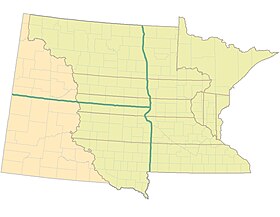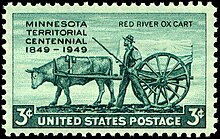Minnesota Territory
| Territory of Minnesota | |||||||||||||
|---|---|---|---|---|---|---|---|---|---|---|---|---|---|
Governor | | ||||||||||||
• 1849–1853 | Alexander Ramsey | ||||||||||||
• 1853–1857 | Willis A. Gorman | ||||||||||||
• 1857–1858 | Samuel Medary | ||||||||||||
| Legislature | Minnesota Territorial Legislature | ||||||||||||
| History | |||||||||||||
| March 3, 1849 | |||||||||||||
| May 11, 1858 | |||||||||||||
| |||||||||||||
The Territory of Minnesota was an
History


The Minnesota Territory was formed on March 3, 1849, encompassing the entirety of the present-day state of Minnesota and the majority portions of modern-day North and South Dakota east of the Missouri and White Earth Rivers.[2] At the time of formation there were an estimated 5,000 settlers living in the Territory. There were no roads from adjoining Wisconsin or Iowa. The easiest access to the region was via waterway, of which the Mississippi River was primary. The primary mode of transport was the riverboat.
Minnesota Territory had three significant pioneer settlements:
The first territorial governor, Alexander Ramsey, requested that Congress approve funds for five military roads in the Territory: Mendota/Fort Snelling to the confluence of the Big Sioux River with the Missouri River; Point Douglas to Fort Ripley; Fort Ripley Road/Swan River to Long Prairie Indian Agency; and Point Douglas to Superior.[6] A budget was approved in 1850 for four of these roads, with the Point Douglas–Fort Ripley Military Road being the first. Additional funds were later appropriated for a survey of the route to the Big Sioux/Missouri, the Fort Ridgely and South Pass Wagon Road and the Wagon Road from Fort Ripley to Fort Abercrombie. Private trails were cut as well, the most well known of which was Dodd Road from 1853. It was named after its builder, Captain William B. Dodd, and significant portions of it still exist.[6]
When the region was still part of the
Later, the Oxcarts became synonymous with St. Paul's Kellogg Street and the riverboat landing on the Mississippi River. Fort Ripley lay along the East Plains Trail.In 1850, 10 years after the end of the Second Great Awakening (1790–1840), of the three churches with regular services in the Minnesota Territory, 1 was Methodist, 1 was Presbyterian, and 1 was Catholic.[7] The Roman Catholic diocese of Saint Paul of Minnesota was established by Pope Pius IX on July 19, 1850, and consisted of the entirety of the Minnesota Territory. Because of this original territorial designation, to this day the Archdiocese of Saint Paul and Minneapolis continues to oversee the Catholic dioceses in the Dakotas within its ecclesiastical province.
In the 1850 United States census, the nine counties in the Minnesota Territory reported the following population counts:[8]
| Rank | County | Population |
|---|---|---|
| 1 | Ramsey | 2,227 |
| 2 | Kittson | 1,134 |
| 3 | Washington | 1,056 |
| 4 | Dakota | 584 |
| 5 | Benton | 418 |
| 6 | Wabasha | 243 |
| 7 | Wahnata | 160 |
| 8 | Mahkahta | 158 |
| 9 | Itasca | 97 |
| Minnesota Territory | 6,077 |
Territorial Governors
| # | Governor | Took office | Left office | Party | |
|---|---|---|---|---|---|
| 1 | Alexander Ramsey | 
|
June 1, 1849 | May 15, 1853 | Whig |
| 2 | Willis Arnold Gorman
|

|
May 15, 1853 | April 23, 1857 | Democratic |
| 3 | Samuel Medary | 
|
April 23, 1857 | May 24, 1858 | Democratic |
Territorial Secretaries
- Charles K. Smith, 1849–1851
- Alexander Wilkin, 1851–1853
- Joseph Rosser, 1853–1857
- Charles L. Chase, 1857–1858
Territorial Attorneys General
- Lorenzo A. Babcock, 1849–1853
- Lafayette Emmett, 1853–1858
Congressional Delegates
- Henry Hastings Sibley, 31st Congress, 32nd Congress, 1849–1853
- Henry Mower Rice, 33rd Congress, 34th Congress, 1853–1857
- William W. Kingsbury, 35th Congress, 1857–1858
See also
- John Catlin
- Historic regions of the United States
- History of Minnesota
- Interior Plains
- Territorial evolution of the United States
- Territory of Dakota, 1861–1889
References
- ^ 9 Stat. 403
- ^ See The Student Page of the Minnesota Secretary of State Archived July 1, 2007, at the Wayback Machine for an overview of how Minnesota's state boundaries were determined.
- ^ "History of the Minnesota Territory". Minnesota Territorial Pioneers. Archived from the original on July 24, 2016. Retrieved August 25, 2019.
- ^ Colbruno, Michael "Lives of the Dead: Mountain View Cemetery in Oakland." December 12, 2009. Retrieved March 5, 2015.
- JSTOR 20177825. Archived from the original(PDF) on October 19, 2012.
- ^ a b c d e A History of Minnesota's Highways Part One, Streets MN webpage, Monte Castleman, February 9, 2018 [1]
- ISBN 978-0816038671.
- ^ Forstall, Richard L. (ed.). Population of the States and Counties of the United States: 1790–1990 (PDF) (Report). United States Census Bureau. pp. 85–87. Retrieved May 18, 2020.
External links
![]() Media related to Minnesota Territory at Wikimedia Commons
Media related to Minnesota Territory at Wikimedia Commons
